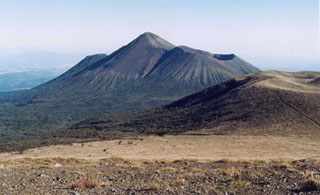Report on Kirishimayama (Japan) — 28 February-6 March 2018
Smithsonian Institution / US Geological Survey
Weekly Volcanic Activity Report, 28 February-6 March 2018
Managing Editor: Sally Sennert.
Please cite this report as:
Global Volcanism Program, 2018. Report on Kirishimayama (Japan) (Sennert, S, ed.). Weekly Volcanic Activity Report, 28 February-6 March 2018. Smithsonian Institution and US Geological Survey.
Kirishimayama
Japan
31.934°N, 130.862°E; summit elev. 1700 m
All times are local (unless otherwise noted)
JMA reported that volcanic earthquakes at Shinmoedake (Shinmoe peak), a stratovolcano of the Kirishimayama volcano group, increased during 24-25 February. Volcanic tremor began to be recorded at 0815 on 1 March and intensified within a few hours. Residents in Takahara-machi, 12 km E (Miyazaki prefecture), reported ashfall at 1100; poor weather conditions prevented visual observations of the volcano. Later that day a small eruption was confirmed. Ashfall was reported in the Takahara-cho neighborhood, 12 km E (Miyazaki prefecture), around 1615. The eruption was observed at 1707 during an overflight. The sulfur dioxide flux was 5,500 tons/day, but then decreased to 2,200 tons/day on 2 March. During 2-3 March gray ash plumes rose as high as 1 km above the crater, and ash fell in Takahara-cho on 3 March. Ash plumes rose 400 m on 4 March. Explosive events on 6 March generated ash plumes that rose 2.3 km. During an overflight observers noted new lava on the E side of the crater, and plumes rising from both the center of the crater and an area on the N side. Ashfall was confirmed over a wide area from Kirishima prefecture and Kagoshima prefecture to the S, to Miyakonojo city (Miyazaki prefecture) to the E. A high number of volcanic earthquakes continued to be recorded. The Alert Level remained at 3 (on a scale of 1-5).
Geological Summary. Kirishimayama is a large group of more than 20 Quaternary volcanoes located north of Kagoshima Bay. The late-Pleistocene to Holocene dominantly andesitic group consists of stratovolcanoes, pyroclastic cones, maars, and underlying shield volcanoes located over an area of 20 x 30 km. The larger stratovolcanoes are scattered throughout the field, with the centrally located Karakunidake being the highest. Onamiike and Miike, the two largest maars, are located SW of Karakunidake and at its far eastern end, respectively. Holocene eruptions have been concentrated along an E-W line of vents from Miike to Ohachi, and at Shinmoedake to the NE. Frequent small-to-moderate explosive eruptions have been recorded since the 8th century.

